
Military Sealift Command (MSC) is an organization that controls the replenishment and military transport ships of the United States Navy. Military Sealift Command has the responsibility for providing sealift and ocean transportation for all US military services as well as for other government agencies. It first came into existence on 9 July 1949 when the Military Sea Transportation Service (MSTS) became solely responsible for the Department of Defense's ocean transport needs. The MSTS was renamed the Military Sealift Command in 1970.

USNS Mizar (MA-48/T-AGOR-11/T-AK-272) was a vessel of the United States Navy. She was named after the star Mizar.

Technical research ships were used by the United States Navy during the 1960s to gather intelligence by monitoring, recording and analyzing wireless electronic communications of nations in various parts of the world. At the time these ships were active, the mission of the ships was covert and discussion of the true mission was prohibited. The mission of the ships was publicly given as conducting research into atmospheric and communications phenomena. However, the true mission was more or less an open secret and the ships were commonly referred to as "spy ships".

USS Zebra (AKN-5) was an Indus-class net cargo ship in the service of the United States Navy in World War II. The ship was originally the Matthew Lyon, an EC2-S-C1 Liberty ship, operated for the War Shipping Administration (WSA) as a cargo vessel by an agent until severely damaged by torpedo in August 1943. While at Espiritu Santo in the New Hebrides awaiting likely scrapping the Navy acquired the vessel under bareboat charter to be used as a net cargo ship transporting reclaimed anti-submarine netting.
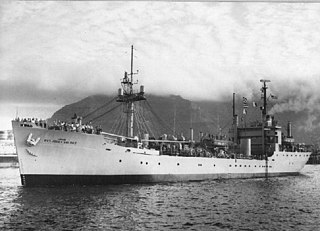
USNS Private Jose F. Valdez (T-AG-169), named after World War II Medal of Honor recipient PFC Jose F. Valdez, was a technical research ship in operation during the 1960s. The "Galloping Ghost of the Ivory Coast" or "Grey Ghost of the African Coast", as she was affectionately called by her crew, was deployed around Africa from 1961 until 1969.

USNS Observation Island (T-AGM-23) was built as the Mariner-class merchant ship Empire State Mariner for the United States Maritime Commission, launched 15 August 1953, and operated by United States Lines upon delivery on 24 February 1954, making voyages for the Military Sea Transportation Service (MSTS) until going into reserve at Mobile, Alabama on 9 November 1954.

USS Thor was a cable repair ship that supported Project Caesar, the unclassified name for installation of the Sound Surveillance System (SOSUS). Originally the Artemis-class attack cargo ship Vanadis (AKA-49) which was briefly in commission from 9 July 1945 to 27 March 1946, it was converted in 1955 after nine years in the reserve fleet.
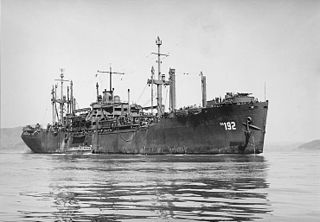
USS Rutland (APA-192) was a Haskell-class attack transport built and used by the US Navy in World War II. She was a Victory ship design, VC2-S-AP5. She was named after Rutland County, Vermont, USA.
USNS Michelson (T-AGS-23) was a Bowditch class oceanographic survey ship of the United States Navy. Launched as the SS Joliet Victory in 1944, Maritime Commission hull number MCV 114, a type VC2-S-AP3 Victory ship, she was named after Albert Abraham Michelson. The ship was reactivated from the James River Maritime Administration Reserve Fleet on 8 February 1958, delivered to the Navy Department at the Philadelphia Naval Shipyard on 8 August 1957 and converted to an AGS by the Charleston Naval Shipyard. USNS Michelson (AGS‑23) was placed in service on 15 December 1958 under the operational control of MSTS Atlantic.
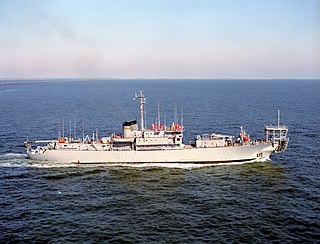
USNS Albert J. Myer (T-ARC-6) was the second of only two Maritime Commission type S3-S2-BP1 ships built for the US Army near the end of World War II intended to support Army Signal Corps communications cables. She is named for Brig. Gen. Albert J. Myer, the founder of the Signal Corps. The other ship was the William H. G. Bullard, later USS Neptune, which Myer later joined in naval service.

USNS Neptune (ARC-2), was the lead ship in her class of cable repair ships in U.S. Naval service. The ship was built by Pusey & Jones Corp. of Wilmington, Delaware, Hull Number 1108, as the USACS William H. G. Bullard named for Rear Adm. William H. G. Bullard. She was the first of two Maritime Commission type S3-S2-BP1 ships built for the US Army Signal Corps near the end of World War II. The other ship was the Albert J. Myer, which later joined her sister ship in naval service as the USNS Albert J. Myer (T-ARC-6).
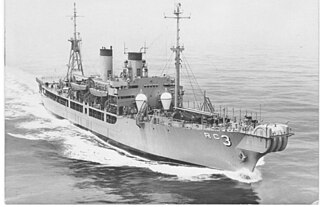
USS Aeolus (ARC-3) began service as USS Turandot (AKA-47), an Artemis-class attack cargo ship built by the Walsh-Kaiser Co., Inc. of Providence, Rhode Island. In 1954 she was converted into a cable repair ship to support Project Caesar, the unclassified name for installation of the Sound Surveillance System SOSUS. Aeolus was the first of two ships, the other being USS Thor (ARC-4), to be converted into cable ships. Aeolus performed cable duties for nearly thirty years, from 1955 to 1973 as a commissioned ship and from 1973 until 1985 as the civilian crewed USNS Aeolus (T-ARC-3) of the Military Sealift Command (MSC). The ship was retired in 1985 and sunk as an artificial reef in 1988.
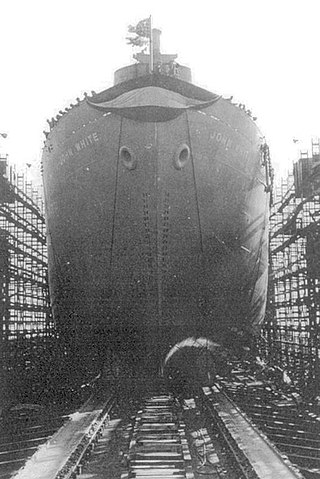
USS Menkar (AK-123) was a Crater-class cargo ship, converted from a Liberty Ship, commissioned by the U.S. Navy for service in World War II. She was first named after John White, a settler among those who sailed with Richard Grenville, to present-day North Carolina, in 1585, to found the Roanoke Colony. White acted as artist and mapmaker to the expedition. He became the governor, in 1587, of the colony, and his granddaughter, Virginia Dare, was the first English child born in the Americas. She was renamed and commissioned after Menkar, the second-brightest star in the constellation of Cetus. She was responsible for delivering troops, goods and equipment to locations in the war zone.

USS Oxford (AGTR-1/AG-159) was an Oxford-class technical research ship, acquired by the U.S. Navy in 1960 and converted for the task of conducting "research in the reception of electromagnetic propagations". She was originally built during World War II as a Liberty-type cargo ship originally named the Samuel R. Aitken.

USNS Private Joe E. Mann (T-AK-253) was a Boulder Victory-class cargo ship acquired in 1950, from the U.S. Army, where she was known as the USAT Private Joe E. Mann.

SS Dalton Victory was built as Victory ship used as a cargo ship for World War II under the Emergency Shipbuilding program. She was launched by the California Shipbuilding Company on 6 June 1944 and completed on 19 July 1944 as a Greenville Victory-class cargo ship. The ship’s United States Maritime Commission designation was VC2- S- AP3, hull number 21. She was acquired by the U.S. Navy in 1950 and renamed the USNS Dalton Victory (T-AK-256).
USNS Sgt. Joseph E. Muller was a C1-M-AV1 cargo ship completed 9 June 1945 and delivered to the War Shipping Administration (WSA) as Check Knot. After operation by WSA's agent Waterman Steamship Company June 1945 – November 1946 and being placed in reserve the ship was transferred to the U.S. Army and renamed USAT Sgt. Joseph E. Muller. She was transferred to the United States Navy in 1950 after the establishment of the Military Sea Transportation Service under Navy and assigned to Korean War supply and transport operations. She was again place back in service in 1962 as one of the civilian crewed, Auxiliary General (AG), technical research ships working on National Security Agency/Naval Security Group missions, based out of Florida. She was finally declared surplus to needs in 1969 and struck.

USNS Sgt. Curtis F. Shoup (T-AG-175) was a C1-M-AV1 coastal freighter. Built as Spindle Eye, one of the many named for knots. The ship, modified to be a "news transmission ship" for the press during the planned invasion of Japan, was completed 9 July 1945, delivered to the War Shipping Administration and placed under its agent Lykes Brothers Steamship Company the same day. Days later, on 26 July, Spindle Eye was bareboat chartered to the War Department for operation by the Army. The ship was renamed November 1947 by the Army, after serving as a radio relay ship at the Operation Crossroads atomic bomb tests and conversion to an Army passenger-cargo vessel, Sgt. Curtis F. Shoup in honor Sergeant Curtis F. Shoup who had been awarded the Medal of Honor.
USNS Flyer (T-AG-178), was a type C2-S-B1 cargo ship of the United States Navy, built for the Maritime Commission (MC) as Water Witch in service under charter by the Commission to several lines until purchased in 1946 by United States Lines and renamed American Flyer. After being placed in the Reserve Fleet 14 December 1964 the title was transferred to the Navy for use as a deep ocean bathymetric survey ship supporting installation of the Sound Surveillance System (SOSUS). The Navy placed the ship in service 9 February 1965 with the name Flyer given on 22 March. The ship operated in that role until 1975.


















